
In most farm accidents, the first person on the scene is usually a family member, employee or neighbor. Generally, that person's knowledge of rescue procedures is limited, and his or her medical training is non-existent. The information presented here is designed to help people with average first-aid knowledge improve their ability to make decisions when they are the first person at the scene of a farm accident.
If you are the first person to arrive on the scene of a farm accident, your actions upon arriving will be based on several factors: your personal safety, the hazards threatening the victim, the victim's condition, and the equipment or animals involved in the accident.
Approaching the Accident
The first decision you'll make is whether it is safe to approach the accident scene. Assess the hazards and the possibility that you could also become a victim. Before you approach the accident, evaluate the potential for additional structural collapse, movement or overturn of machines, fire, chemical hazards or electrocution.
Improper actions can aggravate the victim's injuries or injure you. If you cannot neutralize the hazards to prevent further injury, GO FOR HELP. Rescue and life-saving equipment usually will not be available at the accident site. Try to stabilize the victim and machinery as much as possible and then GO FOR HELP.
Fire is always possible around farm equipment. If petroleum fuels have been spilled, this possibility becomes a probability. All potential fire or explosion sources should be neutralized. If this cannot be safely done, GO FOR HELP.
Electrocution is a hazard when power lines are involved. Do not approach a vehicle that has a power line touching it. Call the power company immediately for assistance and seek additional help.
Chemicals at the accident site can be hazardous to you. If chemicals are involved, avoid touching them or inhaling chemical fumes. Fumes from chemicals spilled on hot exhausts usually will be more toxic than those from normal evaporation. If this hazard cannot be neutralized, GO FOR HELP.
A machine that is wobbly or balancing along the edge of an embankment may tip over if you try moving it or removing the victim. If you can't stabilize the machine to prevent additional movement, GO FOR HELP.
Rescuing a victim caught in a collapsed or exploded building is particularly difficult. Usually heavy materials are involved. Moving only one supporting piece may cause the building or rubble to crush the victim or you. In such cases, GO FOR HELP.
Stabilizing the Victim
After determining that it is safe for you to approach the accident site, stabilize the victim. The order of importance in assisting the victim is ABC. Airway — check to see if the victim is breathing and that his airway is clear. Breathing — establish whether the victim is breathing. Circulation — stop severe bleeding.
Airway:
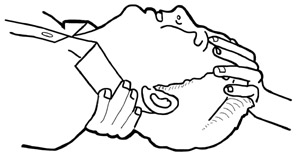
Ensuring an air supply to the victim is more important than stopping any bleeding. If the victim is not breathing, take corrective action immediately. Determine whether the victim is conscious by gently squeezing an arm or shoulder and asking, "Can you hear me?" If there is no response after a second query, check the victim's airway for obstructions. The most common source of airway obstruction in the unconscious accident victim is the tongue. The tongue can be prevented from blocking the airway by tilting the head back, which raises the lower jaw and tongue away from the airway. After gently tilting the head backward, carefully maintain it in that position. Do not move or allow it to move from side to side because that could aggravate any neck or spinal injuries.
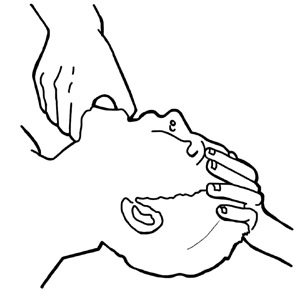
If you suspect a neck injury, use a different method to clear an obstructed airway. Place your fingers on the outer edges of the victim's jawbones, then grasp the sides of the victim's chin with your thumbs. Pull the victim's jaw forward with your thumbs. The jaw muscles of an unconscious victim will relax, forcing the tongue away from the back of the throat, clearing the airway.
Other airway obstructions might include dentures, blood, loose teeth, broken bones, chewing tobacco, chewing gum, dirt or other foreign materials. These items generally can be removed by wiping the inside of the victim's mouth with your forefingers, a piece of cloth or a handkerchief.
Breathing:
The next step is to determine whether the victim is breathing. Observe movement of the victim's chest or place your ear next to the victim's mouth and feel the abdomen. If you cannot feel or hear air movement, then begin artificial resuscitation immediately.
Always be aware that your first priority is to establish that the victim's airway is open and that he or she is breathing. Only then consider stopping any bleeding. Extensive bleeding should not distract you from establishing a clear airway and adequate breathing.
Circulation:
The victim can bleed to death from a severed artery or vein. Arterial bleeding is characterized by spurting blood. Bleeding from the vein is much more even and is not so extensive as arterial bleeding. Regardless of the type of bleeding, three methods of control are available: direct pressure, pressure point control or — as a last resort — tourniquet.
The first choice is direct pressure. It may be applied using a sterile bandage, a clean cloth or, if necessary, your bare hand. Do not remove a blood-soaked compress but add more compresses and apply the direct hand pressure more firmly. The hand pressure prevents blood loss from the body without interfering with normal blood circulation.

If direct pressure does not stop severe bleeding from the arm or leg, pressure point control can some-times stop the bleeding. Pressure points — found in the arm, leg and groin — lie near the areas of bleeding and indicate places where major arteries feeding the wound lie close to the surface. Pressure point control of bleeding is not as satisfactory as direct pressure control on a wound because a wound rarely is supplied by one major compressible artery. The pressure point method will not entirely stop the bleeding but may make direct pressure more effective. Elevating the bleeding point above the heart will help reduce the blood flow also.
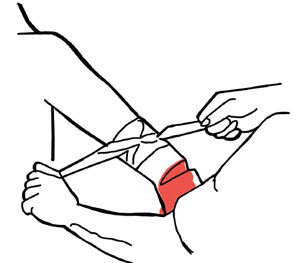
Use a tourniquet, the third method of controlling bleeding, only as a last resort. You must understand that to use a tourniquet is to risk the sacrifice of a limb to save a life. A tourniquet is a wide band of cloth or other material tied very tightly just above the wound to stop all flow of blood. Once a tourniquet is in place, leave it in place until a doctor removes it.
Because tourniquets crush a considerable amount of tissue, they have caused permanent damage to nerves and blood vessels; and if left on for any appreciable length of time, a tourniquet may cause the loss of the limb. If bleeding cannot be stopped any other way, a properly applied tourniquet may be required. In cases of partial or complete amputation or if the other two methods have failed, the tourniquet is the only remaining choice to stop the bleeding.
The life-saving actions presented here have been very brief. You should enroll in a local first-aid and cardiopulmonary resuscitation program (CPR) to become well-trained in caring for accident victims. At least one family member or farm worker should be certified and up-to-date on CPR procedures.
Removing the Victim
The decision to remove the victim from a machine will be based on conditions that vary considerably among accidents. The type of accident, kinds of injuries, rescue equipment available and your knowledge are the major factors determining how much actual rescue you can accomplish.
In machinery accidents, removing the victim from a machine may or may not be the proper action. If the victim has been pinned or wedged in for some time and his or her breathing and circulation are satisfactory, make the victim as comfortable as possible. Then call medical and rescue assistance to the scene immediately.
If imminent danger exists because of fire or the risk of additional injury, immediate rescue attempts are necessary. These actions depend upon the type of accident (machinery, tractor, chemical, fire, etc.) and the victim's condition. Do not attempt to operate machinery to remove the victim unless you are thoroughly familiar with that particular machine. Selecting the wrong gear or operating the hydraulic system improperly may cause additional injury or kill the victim.
Tractor:
The majority of tractor accidents involve overturns, runovers and power takeoff entanglements. The victim of a tractor overturn or runover may have severe fractures and crushing injuries. If you have a shovel, it might be possible to dig beneath the victim to partially relieve the pressure and allow easier breathing. Completely removing the pressure may cause the victim to go into shock or it may remove pressure that is preventing severe internal or external bleeding. If the victim's breathing and circulation are satisfactory, get medical assistance before removing the tractor or machine from the victim. Make sure the victim's airway is clear, that the victim is breathing and that major bleeding has been stopped. The victim of a tractor overturn may suffer burns from leaking fuel, battery acid, motor oil, chemicals, fertilizers and hydraulic fluid. Areas of the body that have come in contact with any of these materials should be flushed with clean, cool water if available. If clean water is not available, other clean drinking fluids can be used to reduce the burning sensation.
If the hazardous materials cannot be stopped from dripping, try to divert their flow with a board or some other resistant material until the victim can be moved.
Power takeoff (PTO) shaft injuries range from minor lacerations to complete body dismemberment. Tools required to rotate the PTO shaft backward may not be readily available, and the victim may occupy the space you require to disassemble the shaft.
The PTO can be disassembled quickly by unhooking the machine from the tractor and slowly driving the tractor forward to pull the PTO shaft apart. The PTO shaft must be in neutral for this operation. If the victim's clothes are caught in the section of the PTO attached to the tractor, they must be cut loose to prevent additional injury to the victim. After the shaft is apart, it will be easier to tend to the victim and safer the leave the victim so you can go for help.
In severe PTO accidents, it may be safest for you to ensure that the victim's life functions are satisfactory and then go for help without trying to remove him or her from the machine.
Machines:
Machinery accidents usually involve entanglements or crushing injuries.
You may be able to remove the victim from the machine by reversing the machine manually. Usually a bar or lever will be required to reverse the machine.
Because the entire machine probably cannot be reversed by hand, the portion of the machine entrapping the victim must be disconnected by locating the drive chain or pulley immediately in front of the area entrapping the victim and disconnecting the belt or chain. If cutting tools are not available, loosen the idler pulley and pull off the drive belt or chain.
Releasing a snap latch or spring also may relieve pressure on the victim. You must be familiar with the machine, however, to know if there are releases and where they are located.
Victims may be caught in the main auger, the cylinder or in the unloading auger of grain combines. It will be especially difficult for one person to rescue a victim from any of these areas. It usually will be best for you, as a lone rescuer, to make sure the life functions of the victim are stable and then go for medical and rescue assistance.
When a farmer changes headers on the combines or works under the header, the header may fall on him. You may need to raise the header or dig under the victim to allow the victim to breathe. Be extremely careful. If you release all the weight, the victim may hemorrhage or go into shock. Shock is quite possible if the victim has been under the weight for some time. If the victim's life functions are satisfactory, go for medical and rescue assistance.
If you absolutely must work under the header, be sure it is blocked to prevent it from falling on you or the victim.
Lifting devices available for you to use include the car or truck jack or bars or timbers used as levers. Place the jack on a board to prevent it from settling into the ground when weight is applied to it. A vehicle bumper jack might work; however, many of them have special lift-attaching devices that function only on the vehicle for which they are designed. Place a board between the ground and lever to prevent the lever from settling into the ground when force is applied to it. Make sure when you lift the header that the lever or jack is supported solidly by the frame. Otherwise, the jack or lever may only puncture or bend the sheet metal and not raise the header significantly.
Hay balers are particularly hazardous machines. If a victim is caught in the feeding rollers, the rollers will pull the victim into the machine — usually up to his shoulders and head. The continuous turning of the rollers will burn the flesh, usually to the extent that the injuries are cauterized and very little bleeding occurs. The hair may become caught in the rollers and the victim partially or entirely scalped. The victim may be drawn in so tight that breathing is difficult. Without tools or equipment, it is virtually impossible to remove the victim from the rollers. Stabilize the victim's life functions and go for medical and rescue assistance.
Injuries associated with the small balers include cuts and puncture wounds from the pickup attachment, crushing injuries, amputation of the extremities or complete body destruction from the augur, bale chamber or tying mechanism.
If tools are available, disconnect the PTO from the tractor and reverse the machine by hand to remove the victim.
Anhydrous Ammonia:
Victims of anhydrous ammonia accidents must be washed completely with water immediately. Flush the exposed areas of the body with water continuously for 15 minutes. Flush the eyes first, forcing the eyelids open. Remove contact lenses. It is vital that the victim's eyes be flushed with water immediately to prevent blindness.
After treating the eyes, saturate the victim's clothing with water before removing it. If water is not readily available, clean drinking fluids can be used, or you can take the victim to a creek, water tank or faucet to flush off the anhydrous ammonia.
Remove the victim from any source of additional contamination. Do not use oils or ointment on burns caused by anhydrous ammonia.
In most accidents involving anhydrous ammonia on the farm, the ammonia will dissipate rapidly and will not be a hazard to the victim's lungs. If the smell is strong enough to cause severe coughing, however, to not enter the area without proper lung protection. You may be able to reach the victim from the upwind side of the accident.
Farm accidents usually do not involve large spills. If a hose breaks and the excess flow valve does not shut off, however, the entire tank of anhydrous ammonia will spray into the atmosphere. It can be stopped only by shutting off the main valve on the tank.
Do not touch the liquid. Wear goggles and rubber gloves if you attempt to shut off any valves. Many local fire departments have the equipment and ability to dissipate the ammonia.
Chemicals:
Chemical accidents are associated not only with the chemicals themselves but also with the application equipment. The accidents include spills while loading, exposure during application or spills following an applicator overturn. Many farm chemicals are toxic if swallowed, spilled on the skin or inhaled.
If possible, approach a chemical accident from upwind. Vapors occur during normal evaporation and if the chemical is spilled on hot engine surfaces in an overturn. Be sure to avoid any puddles of liquids or piles of unknown granules.
Equipment involved in the accident should be shut down. Control leakage so it is not a hazard to you or other rescuers. Remove the victim from the contaminated area, remove contaminated clothing, and wash down the victim. Flush eyes for 15 minutes or longer.
If the victim has swallowed the chemical, try to obtain a package of the chemical and follow the label's instructions for treatment of ingested chemicals.
Storage Structures:
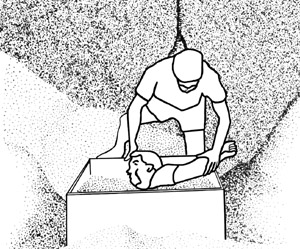
Do not try to pull a victim from flowing grain without assistance. One person cannot prevent the victim from being pulled under the surface of the grain. Shut off the power system operating the auger immediately. If there is an aerating system, start it to move the air through the grain if the victim is totally submerged. Large holes can be cut in all sides of the bin to let the grain fall away from the victim. If the victim is not far beneath the surface, a coffer dam can be built of boards around his head and body. Then remove the grain from the face and place it outside the coffer dam.
A person can be overcome by fumigants in an elevator bin or pit or from gases in silos, cisterns or manure pits. If you find a victim in any of these areas, do not enter without first making sure it is safe to do so. Chemical and respiratory masks are ineffective in manure pits and other kinds of storage structures where oxygen is not present. Even without the presence of poisonous gas, if there is not oxygen a person will usually pass out so fast that he cannot help himself. A self-contained breathing apparatus is required to enter areas without oxygen.
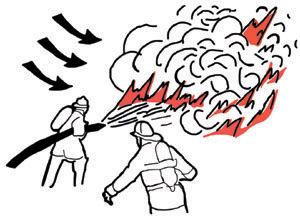
Fire:
You should have fire extinguishers effective on more than one class of fire available for use. An extinguisher rated as 4A:10B, C is effective against fires from combustible, flammable liquids or electrical sources. It is small enough to be handled easily and useful for small fires. It is not suitable for grass or large fires.
Electrocution:
Severe injury or death is possible when coming in contact with electrical power. Most accidents occur when grain augers, grain elevators or aluminum ladders touch overhead lines, although less apparent perils such as exposed wiring can be just as deadly. Respiratory and cardiac arrest are the leading causes of death in electrocution accidents.
Basic precautions need to be followed for a successful rescue that does not lead to further injury to the victim or electrocution of the rescuers. First, before approaching the victim, make sure the victim and surroundings are not still energized. If the victim was electrocuted by overhead or buried lines that feed the farm, call the utility company immediately. Do not approach until it is safe unless the rescuer is trained and equipped to handle the particular situation. If the power source is a breaker box, shut off the main circuit and lock out the breaker box. Once the area is safe, check the victim and initiate basic life support. Treat electrical burns as other burns are treated. Even if the victim seems all right, he or she should be examined by a physician for potential internal injury.
These procedures are not recommended when very high voltage lines are involved. In those cases, contact the utility company immediately.
Livestock Waste Lagoons and Below-Ground Storage Facilities:
Waste lagoons are drowning hazards; be careful when working around them. Sometimes the top will look crusted and appear solid, but this cannot support weight. Use a small boat or dragline to remove someone who has fallen into a waste lagoon.
Below-ground waste storage facilities can produce an assortment of toxic gases from the breakdown of the waste by bacteria. Exposure to high levels of hydrogen sulfide can cause death within seconds. Stirring the liquid can cause the release of additional gas. In any rescue attempt for someone who has succumbed to toxic fumes, try to ventilate the facility as best you can, opening doors and windows and turning on fans. The rescuer must be equipped with a self-contained breathing apparatus (SCBA). Only one rescuer should attempt the rescue with backup rescuers available above ground to pull him out if necessary. Lower additional lifelines and air supply to the rescuer using a tag line. Remove the victim to fresh air as soon as possible and administer life support procedures if necessary. The victim should be seen by a medical professional even if he appears unharmed.
Livestock Accidents:
Rescuing someone injured by an animal can be a very dangerous situation for both the victim and the rescuer. Biting, mauling and kicking can cause lacerations, internal injuries and broken bones. Administer standard first-aid until medical assistance arrives.
The major issue in extrication, however, is getting the victim clear of the animal without further harm to the victim or rescuer. The animal or animals may need to be destroyed to get to the victim safely. If an experienced animal handler is available, ask him or her for help immediately. Pigs, sheep and cattle are herd animals and are calmed in groups. Move an agitated animal to a pen or pasture with other animals if possible. If several animals must be removed from the scene, never yell or chase them. Move the animals by concentrating on the lead animal that the other animals will follow. Avoid sudden movements and loud noises. Small noises (such as rattling a bag) can be useful in moving cattle and sheep. Tame animals can be led from the scene.
Additional Training
Information presented in this bulletin is based on work done at The Agricultural Safety and Health Center located at Kansas State University and the Farm Rescue — Responding to Incidents and Emergencies in Agricultural Settings booklet produced by the NRAES. Training is recommended for emergency medical technicians, rescue and fire department personnel, law enforcement personnel and farm families.
Status and Revision History
Published on Feb 20, 2003
Published on Feb 20, 2009
Published on May 14, 2009
Published with Full Review on May 25, 2012
Published with Full Review on Apr 11, 2017


























































